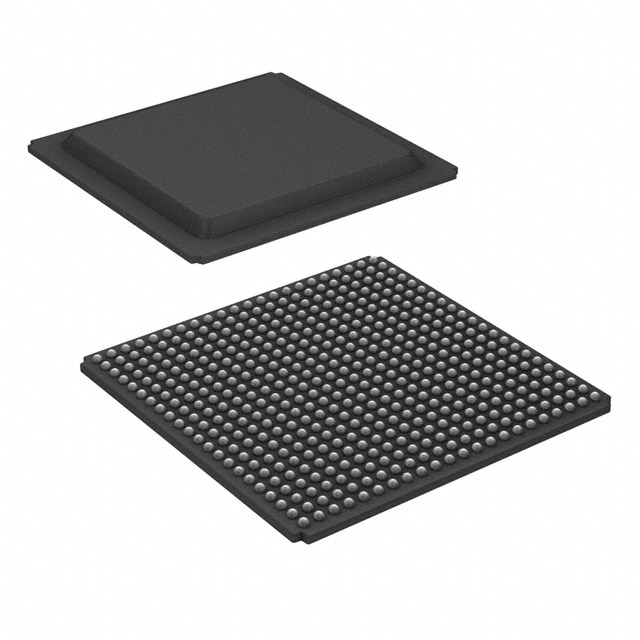Viz Specifikace pro podrobnosti o produktu.

XC7A15T-2FGG484I
Product Overview
Category
The XC7A15T-2FGG484I belongs to the category of Field-Programmable Gate Arrays (FPGAs).
Use
FPGAs are integrated circuits that can be programmed and reprogrammed to perform various digital functions. The XC7A15T-2FGG484I is specifically designed for applications requiring high-performance processing, such as in telecommunications, automotive, aerospace, and industrial sectors.
Characteristics
- High-performance FPGA with advanced features
- Low power consumption
- Flexible and reconfigurable design
- High-speed data processing capabilities
- Support for various communication protocols
- Integration of multiple peripherals and interfaces
Package and Quantity
The XC7A15T-2FGG484I is available in a Fine-Pitch Ball Grid Array (FBGA) package. Each package contains one unit of the FPGA.
Specifications
- FPGA Family: Artix-7
- Logic Cells: 14,400
- Look-Up Tables (LUTs): 9,100
- Flip-Flops: 18,200
- Block RAM: 36,000 bits
- DSP Slices: 80
- Maximum Operating Frequency: 450 MHz
- I/O Pins: 484
- Voltage Range: 1.2V
- Operating Temperature Range: -40°C to +100°C
Pin Configuration
The detailed pin configuration of the XC7A15T-2FGG484I can be found in the manufacturer's datasheet or reference manual.
Functional Features
- High-speed data processing: The XC7A15T-2FGG484I offers fast processing capabilities, making it suitable for applications requiring real-time data handling.
- Reconfigurability: The FPGA can be programmed and reprogrammed to adapt to changing requirements, allowing for flexibility in system design.
- Integration of peripherals: The FPGA includes multiple built-in peripherals and interfaces, reducing the need for external components and simplifying system integration.
- Support for communication protocols: The XC7A15T-2FGG484I supports various communication protocols, enabling seamless connectivity with other devices or systems.
Advantages and Disadvantages
Advantages
- High-performance processing capabilities
- Low power consumption
- Flexible and reconfigurable design
- Integration of multiple peripherals
- Support for various communication protocols
Disadvantages
- Relatively high cost compared to other programmable logic devices
- Steeper learning curve for programming and utilizing the FPGA's full potential
Working Principles
The XC7A15T-2FGG484I operates based on the principles of digital logic. It consists of configurable logic blocks, interconnects, and input/output elements. The logic blocks can be programmed to perform specific functions, while the interconnects allow for the routing of signals between different blocks. The input/output elements provide the interface between the FPGA and external devices.
Application Field Plans
The XC7A15T-2FGG484I finds applications in various fields, including: - Telecommunications: Used in network equipment, base stations, and data centers for high-speed data processing and protocol handling. - Automotive: Employed in advanced driver-assistance systems (ADAS), infotainment systems, and engine control units (ECUs) for real-time processing and control. - Aerospace: Utilized in avionics systems, satellite communication, and radar systems for reliable and high-performance signal processing. - Industrial: Applied in industrial automation, robotics, and control systems for precise and efficient data processing and control.
Alternative Models
- XC7A35T-2FGG484I: A higher-capacity version of the XC7A15T-2FGG484I with increased logic cells and I/O pins.
- XC7A50T-2FGG484I: A higher-performance variant with more logic cells, DSP slices, and block RAM.
These alternative models offer different levels of performance and capacity to suit specific application requirements.
Word count: 477 words
Seznam 10 běžných otázek a odpovědí souvisejících s aplikací XC7A15T-2FGG484I v technických řešeních
Sure! Here are 10 common questions and answers related to the application of XC7A15T-2FGG484I in technical solutions:
Q: What is XC7A15T-2FGG484I? A: XC7A15T-2FGG484I is a specific model of Xilinx Artix-7 FPGA (Field-Programmable Gate Array) with 15,850 logic cells and various I/O interfaces.
Q: What are the key features of XC7A15T-2FGG484I? A: Some key features include low power consumption, high-performance processing capabilities, integrated memory blocks, and support for various communication protocols.
Q: In what applications can XC7A15T-2FGG484I be used? A: XC7A15T-2FGG484I can be used in a wide range of applications such as industrial automation, automotive electronics, medical devices, aerospace systems, and telecommunications.
Q: How can XC7A15T-2FGG484I be programmed? A: XC7A15T-2FGG484I can be programmed using Xilinx's Vivado Design Suite, which provides a comprehensive development environment for FPGA designs.
Q: What are the advantages of using XC7A15T-2FGG484I in technical solutions? A: Some advantages include its flexibility, reconfigurability, high-speed processing capabilities, and ability to handle complex algorithms and data processing tasks.
Q: Can XC7A15T-2FGG484I interface with other components or devices? A: Yes, XC7A15T-2FGG484I supports various I/O standards and can interface with other components or devices such as sensors, actuators, memory modules, and communication interfaces.
Q: What kind of development tools are available for XC7A15T-2FGG484I? A: Xilinx provides a range of development tools including Vivado Design Suite, Software Development Kit (SDK), IP cores, and debugging tools to aid in the development of applications using XC7A15T-2FGG484I.
Q: Can XC7A15T-2FGG484I be used in safety-critical applications? A: Yes, XC7A15T-2FGG484I can be used in safety-critical applications as it supports various safety features such as error correction codes (ECC) and built-in self-test (BIST) capabilities.
Q: Are there any limitations or considerations when using XC7A15T-2FGG484I? A: Some considerations include power consumption, thermal management, and the need for proper design and verification practices to ensure reliable operation.
Q: Where can I find more information about XC7A15T-2FGG484I and its application in technical solutions? A: You can refer to the official documentation provided by Xilinx, including datasheets, user guides, application notes, and online forums for further information and support.

